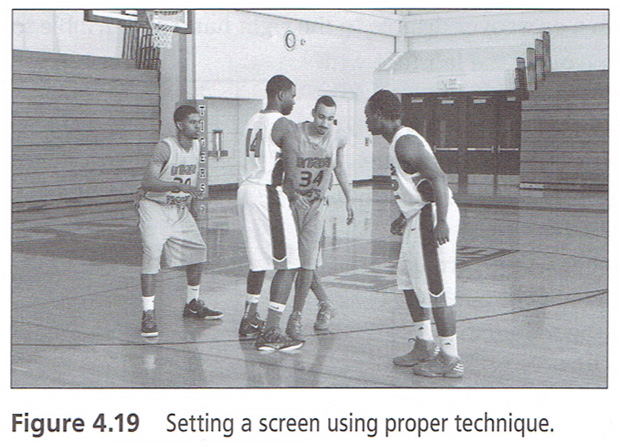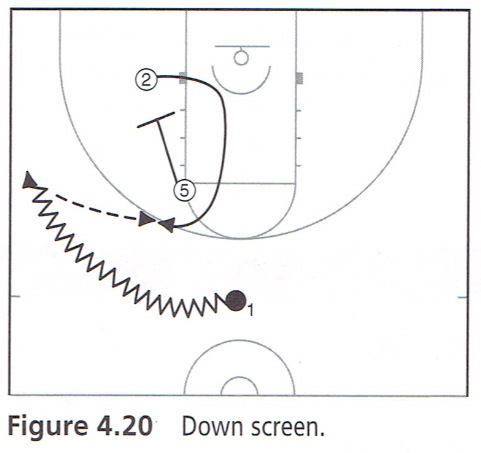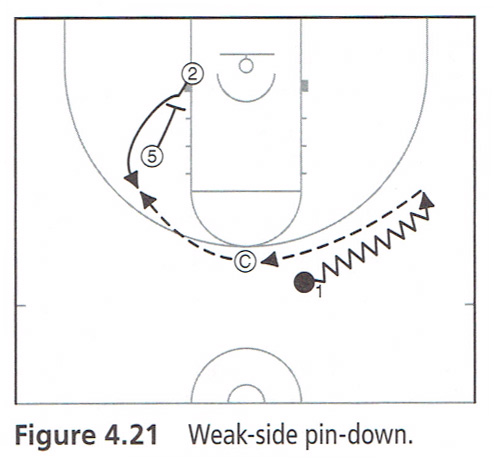| Screening |
| By: Lee Rose
Originally Published in: Winning Basketball Fundamentals Provided by: Human Kinetics The player setting the screen should have the feet shoulder-width apart and the arms down in front of the body with one hand over the other in a protective mode (figure 4.19). The player cannot lean, extend the elbows or knees, or turn into the defender. Technique is important, and in most situations the player setting the screen is responsible for establishing a legal screen, which means being stationary at the time of the screen and making sure that the player being screened is permitted distance and proper vision. For example, a player who screens in front or at the side of a stationary opponent may be as close to the player being screened as he desires because the opponent being screened can see the screener. But if the screen is set behind the opponent, the opponent is entitled to take one normal step before contact. In other words, the screener must give the opponent distance to turn (meaning that the screener cannot touch him), and the screener must allow the opponent who is turning to see him. Thus, the player must give the opponent distance and vision, or he will be called for a foul.
The player using the screen has the responsibility of making sure that the timing is proper; if he moves too soon, an offensive foul occurs. Moving too soon is a fundamental mistake because the player using the screen fails to set up his man properly and moves before the screener can establish a stationary position. Thus, the timing of the screen is a shared responsibility that requires both players to coordinate their movements. Teaching players how to set and use screens is vitally important to developing an effective offense. To teach proper screening techniques, use a walk-through to show players how to set and use screens. The following drills will help. DOWN SCREEN Focus Screening execution for the down screen. Procedure Split the squad into groups of three and use both ends of the court. Begin on the half court, illustrating with no defense, and then go live three on three-offense to defense, defense off. Follow these steps: 1. O1 dribbles to the free-throw line extended and prepares to pass to O2. 2. The zipper down screen (a down screen for a player on the low block, who "zips" up off the screen) occurs when O5 at the elbow sets a screen for O2 on the low block on the same side (figure 4.20). 3. To use the screen, the player should jab-step in either direction, trying to get the defender between the screen and himself. 4. If the defender does not go with the jab step, the offensive player goes to the top of the key on the inside, closest to the passer. 5. If the defender takes the fake, the offensive player comes up the middle. 6. Continue live three-on-three play until a shot is made or the defense obtains the ball.
WEAK-SIDE PIN-DOWN Focus Screening execution and timing for the weak-side pin-down. Procedure Split the squad into groups of three and use both ends of the court. Begin on the half court, illustrating with no defense, and then go live three on three-offense to defense, defense off. Follow these steps: 1. On the right side, O1, with the ball, lines up 6 feet (2 m) beyond the top of the key in direct line with the elbow. Use a coach as the middle passer. 2. The play begins when O1 dribbles to the free-throw line extended and passes to the coach at the top of the key. 3. After this ball reversal, player O5 sets a weak-side pin-down screen (figure 4.21; note that weak-side pin-downs can be a single or double screen). The player setting the screen (O5) cannot move on the screen. 4. O2, the user of the screen, must run with a purpose. He should read the defense and go away from or eliminate resistance. If the defender blocks the route, the offensive player must find an alternative. 5. Continue live three-on-three play until a shot is made or the defense obtains the ball. When players learn to run their routes with a purpose, the offense becomes fluid.
CROSS SCREEN Focus Screening execution and technique for cross screens. Procedure Split the squad into groups of three and use both ends of the court. Begin on the half court, illustrating with no defense and then go live three on three-offense to defense, defense off. Follow these steps: 1. Play begins on the left side as O1, with the ball, lines up 6 feet (2 m) beyond the top of the key in direct line with the elbow. O1 dribbles to the free-throw line extended, 3 feet (1 m) from the sideline. 2. Player O2 sets a cross screen for player O4 (figure 4.22). Cross screens close to the basket can be extremely physical. Thus, the screener (O2) must be prepared for contact and the big man (O4) cannot move early; otherwise, he will never clear the congested area. Player O4 should wait, move away from resistance, and be quick after starting. 3. After the screen, player O1 looks to pass inside to O4. Player O2 must clear the lane quickly to avoid a three-second violation. 4. Continue live three-on-three play until a shot is made or the defense obtains the ball.
Note that cross screens with a small man screening a big man are excellent for getting the ball on the low post. Defenses seldom switch because of the mismatch. Cross screens are most often used by teams that have good post-up players. Successful teams usually have at least three players capable of posting up. |









